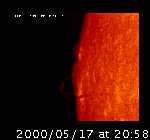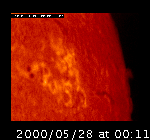The future will be written by what we do here on earth *and* how well we adapt to and are prepared for changes to the Sun that will affect life and death on this planet.
The links and discussion forums that are listed below are meant to keep you informed and communicating regarding this subject.
 Ask us to post links to Sun pages that you know of. Ask us to post links to Sun pages that you know of.
GlobalHome.com News
Solar Effects
 Links to resources regarding how the Sun effects our global circumstances...
Links to resources regarding how the Sun effects our global circumstances... It's all in the star.
Solar Effects  [participatory/news] posts here. [participatory/news] posts here.
 NOAA National Oceanic and Atmospheric Administration - Source: NASA NOAA National Oceanic and Atmospheric Administration - Source: NASA
Space Environment Center
Providing space weather alerts and warnings to the nation and the world for disturbances that can affect people and equipment working in space and on Earth... [visit]
Advisories [visit]
Latest Space Weather [visit]
Geomagnetic Data [visit]
Solar Images [visit]
 NOAA Space Weather Scales - Source: NASA NOAA Space Weather Scales - Source: NASA
Calculating the effects of solar weather on Earth/near Earth sysytems. Includes Geomagnetic Storms, Solar Radiation Storms and Radio Blackouts
The NOAA Space Weather Scales were introduced in November 1999 as a way to communicate to the general public the current and
future space weather conditions and their possible effects on people and systems. Many of the SEC products describe the space
environment, but few have described the effects that can be experienced as the result of environmental disturbances. These scales
then should be useful to users of our products and those who are interested in space weather effects.
The scales describe the environmental disturbances for three event types: geomagnetic storms, solar radiation storms, and radio
blackouts. The scales have numbered levels, analogous to hurricanes, tornadoes, and earthquakes that convey severity. They list
possible effects at each level. They also show how often such events happen, and give a measure of the intensity of the physical
causes... [visit]
 The Solar and Heliosheric Observatory - Source: NASA The Solar and Heliosheric Observatory - Source: NASA
SOHO What's New
News from The Solar and Heliosheric Observatory... [visit]
SpaceWeather.com
Daily news of current solar activity conditions, sunspots, geomagnetic storms and more... [visit]
Sunspot Cycle Predictions
Predicting the behavior of a sunspot cycle is fairly reliable once the cycle is well underway... [visit]
 Home of the Northern Lights - Source: Jan Curtis Home of the Northern Lights - Source: Jan Curtis
I have received many questions concerning the best place and time of year to view the Northern Lights... [more]
Auroral Activity Observation Network
Global maps showing auroral activity... [visit]
Hourly STD DMSP/POLAR Auroral Activity Report
Use this web page to obtain current auroral activity sighting reports from around the world... [visit]
 Solar Storms and You! - Source: NASA Solar Storms and You! - Source: NASA
Scientists have found that there is a possible correlation between the average ocean temperature and the solar sunspot activity. By comparing the
results from the data that has been collected since the 1800's to the present, scientists have found a possible pattern.
Polar Substorm
On March 2, 2000, NASA's Polar satellite spotted a geomagnetic storm triggered by a gust of solar wind. [read]
 Remote Sensing Data and Information - Source: NASA Remote Sensing Data and Information - Source: NASA
 Ask A Space Scientist - Source: NASA Ask A Space Scientist - Source: NASA
[Q]
How are sun spots related to Earth's weather?
[A]
We don't know exactly. During the 1600's, there were no sun spot cycles observed, and Europe was in the
grip of what climatologists call the Little Ice Age. Since 1700, there have been more or less regular cycles
of typical length 11 years. Careful measurements of the luminosity of the Sun from satellite observations
have shown that, when sun spots are present, the Sun is actually brighter, even though the spots themselves
are dark! [more]
[Q]
Will my computer crash because of a solar storm?
[A]
Probably not, but there are several ways that this could happen.
Severe solar storms can, and do, affect the power grid. They can trigger actual black outs like the one
that happened in Quebec in March 1989, and they can cause temporary instabilities in the power levels.
These are not the 'spikey' kinds of events that most computer power supplies can protect against, but
long-term surges and sags lasting several minutes or hours. If transformers get over heated from the
induced DC currents produced by geomagnetic storms, then you could end up with localized problems in
the grid that supplies your neighborhood. In Canada they have lots of problems with geomagnetic storm
currents that get induced into their power grid and local brownouts are rather common during strong
auroral displays. In the United States, though, we rarely have these events in our electrical system. [more]
[Q]
How does the solar wind affect the Earth?
[A]
It affects it by the intense clouds of high energy particles that it often contains which are produced by solar storms. When
these clouds, called coronal mass ejections, make their way to the Earth in 3-4 days, they collide with the magnetic field of
the Earth and cause it to change its shape. [more]
 Basic guide to our Sun - Source: NASA Basic guide to our Sun - Source: NASA
 Search results for 'solar and sun' - Source: NASA Search results for 'solar and sun' - Source: NASA
 Ask A Physicist Sun-Earth Connections - Source: NASA Ask A Physicist Sun-Earth Connections - Source: NASA
[Q]
What if there was a solar flare or electro-magnetic pulse so violent that while biological life was mostly unaffected, communications satellites, power grids, and electronics of all kinds went out of service indefinitely? Can unusually strong solar activity physically damage electrical and electronic equipment significantly and permanently? Could equipment be shielded to prevent such interference?
[A]
I don't think that there is any way solar activity could destroy our electronics "permanently" without wiping out the human race. We can shield against virtually anything that is survivable, and there are communication methods that don't use radio waves (laser, fiber optic, etc.). Solar activity could take out electronics and certainly communications in the short term, but with some work, I'm pretty sure we would deal with it.
 Solar Image Index - Source: Presented by the Space Environment Center Solar Image Index - Source: Presented by the Space Environment Center
Sample Image

Image index of daily solar activity by date. How To Use: Go to index page... Refer to the columns at the
right for the year you are
interested in. Click on a
month in that column. The
daily solar image pages
available for that month and
year will appear in the far
right column. Finally,
select the particular day you
are interested in, and a new
page will appear showing
the solar images received
that day. The current month
is shown by default.
|



